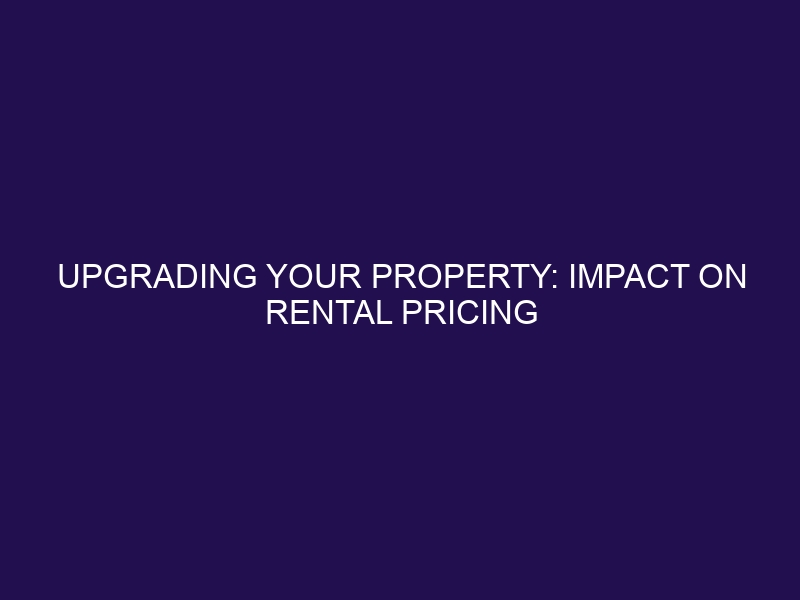Upgrading Your Property: Impact on Rental Pricing
Property upgrading refers to the process of making improvements and renovations to a rental property to increase its value and appeal to potential tenants. These upgrades can range from small cosmetic changes to major structural renovations, depending on the needs of the property and the budget of the landlord.
Upgrading your property can have a significant impact on rental pricing and attract more high-quality tenants. A study by real estate experts Jones Lang LaSalle (JLL) found that properties with upgraded amenities and features can command higher rental prices and have lower vacancy rates. Additionally, upgrades can also lead to increased property value, making it a profitable long-term investment.
Some of the reasons why landlords should consider upgrading their property include:
- Attracting More Tenants: Upgraded properties are more likely to appeal to a wider pool of potential tenants, increasing the chances of finding suitable tenants quickly.
- Increasing Property Value: Upgrades can add value to the property, making it a more attractive investment for future buyers or investors.
- Improving Tenant Satisfaction: Upgrades can improve the overall living experience for tenants, leading to higher satisfaction and longer tenancy periods.
- Keeping Up with Market Trends: Upgrading the property can help it stay competitive with other rental properties in the market and meet the changing demands of tenants.
There are different types of property upgrades that landlords can consider, depending on their budget and the needs of the property. These include:
- Cosmetic Upgrades: Simple changes like painting, updating fixtures, and adding new appliances can give the property a fresh and modern look.
- Functional Upgrades: These upgrades focus on improving the functionality of the property, such as installing energy-efficient appliances or upgrading the heating and cooling systems.
- Structural Upgrades: These are major renovations that involve significant changes to the property’s structure, such as adding an extra room or expanding the living space.
Property upgrading can have a direct impact on rental pricing. Some benefits of upgrading your property include:
- Increase in Rental Price: Upgraded properties can command higher rental prices, allowing landlords to earn more from their investment.
- Attracting Higher Quality Tenants: Upgraded properties are more likely to attract tenants who are willing to pay a premium for a well-maintained and upgraded living space.
- Decrease in Vacancy Rates: Properties with upgraded amenities and features are in high demand, leading to lower vacancy rates and minimizing the risk of rental income loss.
When considering property upgrading, landlords should take into account several factors, such as their budget, market demand, property location, and tenant demographics. It is essential to research the local market and understand the needs and preferences of potential tenants to make informed decisions about which upgrades to prioritize. Ultimately, investing in property upgrades can lead to higher rental income and a more profitable investment in the long run.
What Is Property Upgrading?
What Is Property Upgrading?
Property upgrading refers to the process of making improvements or renovations to a property in order to increase its value and appeal to potential renters. This can involve modernizing the interior, updating appliances, or enhancing amenities to attract higher rental prices.
Some suggestions for property upgrading include:
- incorporating energy-efficient upgrades
- stylish fixtures
- creating outdoor living spaces
Why Should You Upgrade Your Property?
As a property owner, investing in upgrades can be a daunting decision. However, the benefits of upgrading your property can greatly outweigh the initial cost. In this section, we will discuss the various reasons why upgrading your property is a wise choice. From attracting more tenants to increasing the overall value of your property, we will explore how these upgrades can have a positive impact on your rental pricing. Additionally, we will touch upon the importance of keeping up with market trends and how upgrades can improve tenant satisfaction.
1. Attracting More Tenants
- Enhance Curb Appeal: Maintain well-groomed landscaping and exterior maintenance to attract more tenants.
- Upgrade Amenities: Add appealing features like a fitness center or communal spaces to attract potential tenants.
- Quality Finishes: Utilize high-quality materials and modern design to entice potential tenants.
2. Increasing Property Value
- Enhance curb appeal through landscaping and exterior maintenance to increase property value.
- Upgrade interior features such as flooring, countertops, and fixtures to add value to your property.
- Invest in energy-efficient appliances and systems to not only save money, but also increase sustainability and property value.
- Optimize space functionality by implementing smart renovations and storage solutions that can add value to your property.
3. Improving Tenant Satisfaction
- Communication: Consistently communicate with tenants to address any concerns and gather valuable feedback.
- Amenities: Improve common areas and consider providing additional facilities based on tenant preferences.
- Maintenance: Respond promptly to repair requests and maintain the property in excellent condition.
4. Keeping Up with Market Trends
Staying current with market trends is crucial for property upgrading. By staying informed about design, technology, and sustainability trends, you can attract discerning tenants, boost property value, and improve tenant satisfaction. Adapting to market shifts ensures that your property remains competitive and desirable in the rental market.
What Are the Different Types of Property Upgrades?
Property upgrades can greatly enhance the value and appeal of a rental property, but not all upgrades are created equal. In this section, we will explore the various types of property upgrades that landlords and property owners can consider. From simple cosmetic improvements to more substantial functional and structural upgrades, each type offers its own unique advantages and considerations. By understanding the different categories of property upgrades, you can make informed decisions on which upgrades will have the greatest impact on your rental pricing.
1. Cosmetic Upgrades
- Start with a fresh coat of paint, opting for neutral tones.
- Upgrade lighting fixtures and window treatments for a modern look.
- Consider replacing old hardware and faucets for a polished finish.
- Enhance curb appeal with landscaping and exterior touch-ups.
When considering cosmetic upgrades, focus on small changes that make a big impact, aligning with current design trends for a timeless appeal.
2. Functional Upgrades
- Enhance Efficiency: Upgrade lighting, HVAC systems, and insulation for better functionality and cost savings.
- Upgrade Appliances: Install energy-efficient appliances to improve efficiency and reduce costs.
- Improve Security: Enhance door locks, surveillance systems, and fire safety for increased functionality and peace of mind.
Did you know? Functional Upgrades can greatly reduce operational costs for property owners.
3. Structural Upgrades
- Assess the structural integrity of the property, focusing on the foundation, walls, and support beams, as part of the Structural Upgrades process.
- Consider adding reinforcements or seismic retrofitting to enhance the building’s resilience as part of the Structural Upgrades process.
- Upgrade plumbing and electrical systems to meet modern safety and efficiency standards as part of the Structural Upgrades process.
How Does Property Upgrading Affect Rental Pricing?
As a property owner, making upgrades to your rental property can greatly impact its rental pricing. In this section, we will discuss the various ways in which property upgrading can affect the rental price of your property. From attracting higher quality tenants to increasing the rental price and decreasing vacancy rates, we will explore the potential benefits of upgrading your property. Let’s dive into the details and see how these upgrades can make a difference in your rental pricing strategy.
1. Increase in Rental Price
- Conduct market research to analyze the current rental prices in the area and identify potential opportunities for an increase.
- Identify property upgrades that align with tenant demand and add value to justify a higher rental price.
- Strategically implement these upgrades to effectively justify the increased rental price.
2. Attracting Higher Quality Tenants
- Enhance property curb appeal and interior aesthetics to attract higher quality tenants.
- Upgrade amenities to align with high-quality standards and appeal to discerning tenants.
- Implement security features to ensure tenant safety and peace of mind.
- Offer sustainable and energy-efficient solutions to attract environmentally-conscious tenants.
Did you know? Upgraded properties can command up to 20% higher rental rates, making them more attractive to higher quality tenants.
3. Decrease in Vacancy Rates
- Enhance property appeal through upgrades to attract more tenants and decrease vacancy rates.
- Meet tenant needs with functional upgrades, reducing turnover and decreasing vacancy rates.
- Implement security enhancements to increase tenant confidence and decrease vacancy rates.
What Are the Factors to Consider When Upgrading Your Property?
When it comes to upgrading your rental property, there are several factors to consider before making any decisions. These factors can greatly impact the rental pricing and ultimately, your return on investment. In this section, we will discuss the key considerations such as budget, market demand, property location, and the demographics of potential tenants. By understanding these factors, you can make informed decisions on how to upgrade your property to maximize its rental potential.
1. Budget
- Evaluate current financial status.
- Estimate potential upgrade costs.
- Consider financing options if necessary.
- Prioritize upgrades based on budget constraints.
Story: Sarah meticulously planned her property upgrade, aligning each improvement with her budget to revamp the rental space without overspending.
2. Market Demand
- Conduct thorough research on the local real estate market to gain an understanding of the current demand levels.
- Identify property features that align with the most sought-after amenities in the market to attract potential tenants.
- Consult with real estate professionals to gain valuable insights into the specific needs and preferences of potential tenants in the market.
3. Property Location
- Accessibility: When considering a property location, it is important to take into account its proximity to public transportation, major roads, and highways for convenience.
- Neighborhood: One should also evaluate the safety, amenities, and overall appeal of the neighborhood to ensure tenant satisfaction.
- Market demand: It is crucial to research the demand for rental properties in the specific location to ensure a steady flow of tenants.
4. Tenant Demographics
Tenant demographics play a significant role in determining upgrade decisions. For example, young professionals may prioritize modern amenities, while families may place a higher value on space and safety. Having a thorough understanding of tenant demographics allows for targeted upgrades that cater to and retain specific tenant groups.
Frequently Asked Questions
What are some cost-effective rental property upgrades that will have a high impact on rental pricing?
Some cost-effective rental property upgrades that can have a high impact on rental pricing include upgrading flooring, painting, focusing on small details, and strategically planning upgrades based on the target market and location of the rental property.
How can upgrading my rental property help generate higher rental income?
Upgrading your rental property can attract and retain good tenants, ultimately leading to higher demand and the ability to charge higher rental rates. It can also justify expenses for rent increases and potentially lead to a higher market rate for your rental property.
What are some low-cost rental property upgrades that can have a big impact on the overall appearance and value?
Some low-cost rental property upgrades include painting with warm neutral tones, adding fresh landscaping, and focusing on small details like replacing cracked electrical outlets and light switches. These upgrades can give your rental property a modern flare and a sense of care.
Is it worth sinking more money into large scale renovations for my rental property?
It depends on the location and surrounding properties. Investing a lot of money in high-end upgrades may not be worth it if the property is not in a desirable location or surrounded by lower-end properties. It’s important to carefully consider the potential return on investment for each upgrade.
What are some ways to cut expenses while still making impactful rental property improvements?
One way to cut expenses is to take advantage of big holiday sales or discounts on materials and supplies. Another way is to opt for DIY projects and save on labor costs. Additionally, choosing durable and easy-to-maintain materials can save money in the long run.
How can I justify spending capital on rental property upgrades?
Upgrading your rental property can lead to increased rental income and justify the initial expenses. It can also attract a larger audience of prospective renters and lead to higher rental rates. Additionally, with interest-free payment options or cash back incentives, upgrading can be a financially savvy decision.







